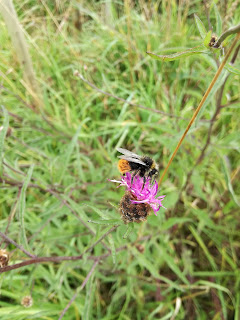Winkleigh Biodiversity Group, assisted by many volunteers from the local community, has been responsible for managing "The Mound" since August 2012, when the Trustees of Winkleigh War Memorial Recreation Field offered us a small, neglected and unused area. Back then, we were just a group of enthusiastic people wanting to create a wild space where Nature could thrive. We initially called it The Wild Flower Project, until the idea of the Spiral Maze was born. The story of our efforts since the first work-party in August 2012 has been told in these pages. Since then we have recorded over 100 species of plant, bird, mammal, insect and reptile and sent these records to Devon Biodiversity Records Centre.
Over the past few months we have been in discussion with the Trustees about changes to the original boundary of "The Mound". First, the boundary hedge was removed last Summer. The muddy tracks made by the large machinery were not surprisingly not a pretty sight!
 |
| Muddy tracks |
 |
| View of old shed |
 |
| View with Leylandii Hedge 29 August 2022 |
Then proposals were made to reduce the area significantly, in order to accommodate a junior football pitch. After some months of negotiation, a compromise plan was reached which would move the boundary to half-way across the first row of trees in The Spiral. This plan minimised the removal and relocation of existing trees and shrubs, which was carried out while they were dormant. A line was marked out with sticks and yellow tape to show the new boundary. The proposed pitch will take up all of the first grass path which used to run alongside the boundary Leylandii hedge and approximately half of the the first hedge-row of trees and shrubs.
 |
| Yellow tape marking the new boundary |
As part of these changes, Winkleigh Biodiversity Group's agreement to rent "The Mound" will not renew on May 1st this year. The Trustees will be taking over responsibility for its management, with co-operation from Biodiversity Group members in a joint working group. This is the start of a new arrangement for the two organisations, but we hope that the biodiversity there will continue to flourish and develop 'under new management'. As part of the plan, recognising the impact on wildlife of the reduction of area, another space has been set aside as an extension to the biodiversity area. This additional area will nearly double the area set aside for Nature. The two areas joined together will have a new name - Winkleigh's Community Nature Area. More on this in the next instalment.















































.jpg)


